Quantitative Method Homework: Probability and Statistics
VerifiedAdded on 2022/08/14
|11
|1176
|9
Homework Assignment
AI Summary
This document presents a comprehensive solution to a quantitative methods homework assignment. The solution addresses several key concepts in probability and statistics, including calculating probabilities of independent events, such as firefighters and police strikes. It also explores the normal distribution, calculating probabilities within specific ranges using z-scores and standard deviations, and applying it to real-world scenarios like employee performance. Furthermore, the solution delves into the binomial distribution, solving problems involving the probability of successes in a fixed number of trials, such as the probability of cities receiving grants. The assignment covers topics from basic probability rules to advanced statistical distributions, providing a detailed analysis of each problem and its solution.
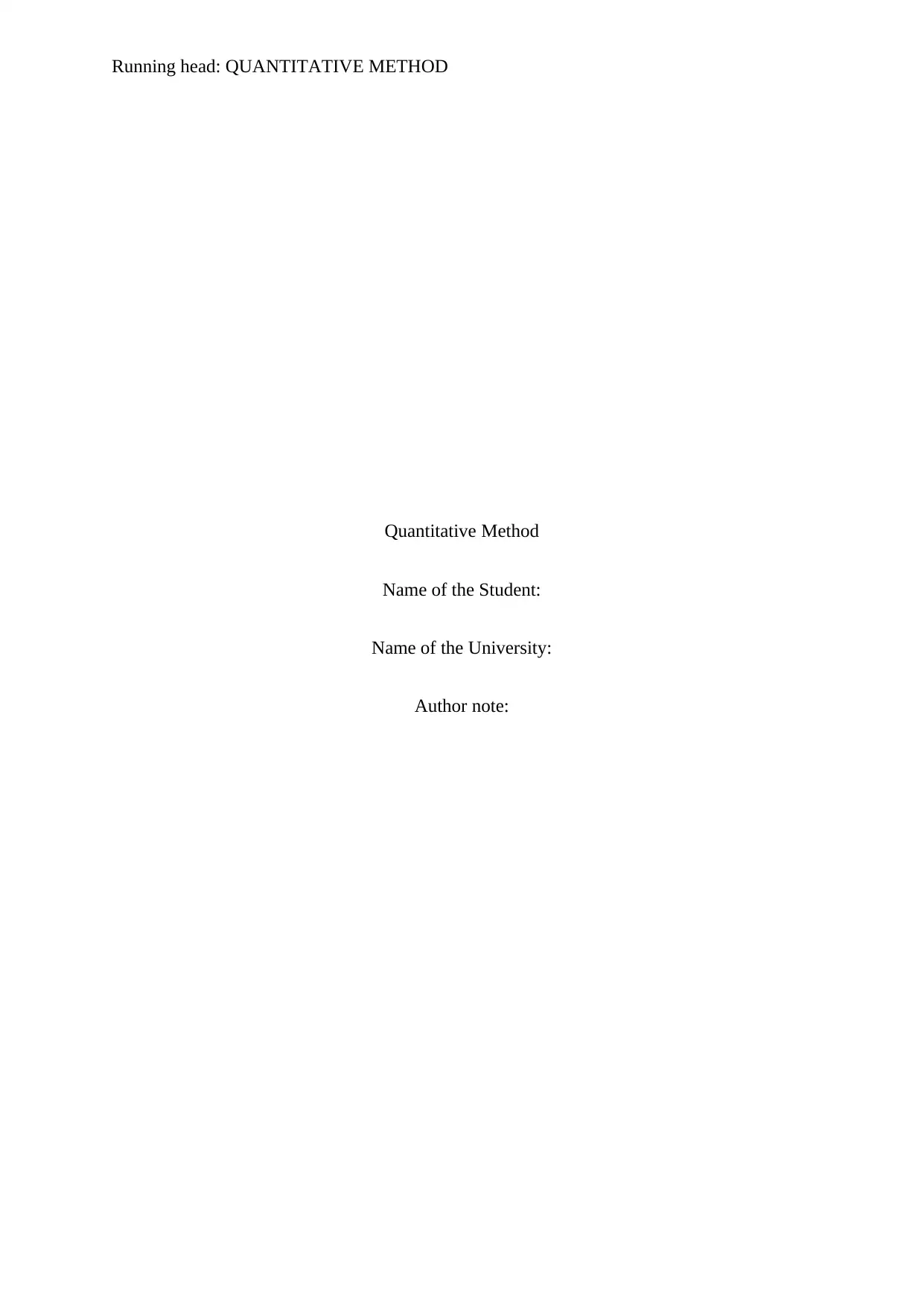
Running head: QUANTITATIVE METHOD
Quantitative Method
Name of the Student:
Name of the University:
Author note:
Quantitative Method
Name of the Student:
Name of the University:
Author note:
Paraphrase This Document
Need a fresh take? Get an instant paraphrase of this document with our AI Paraphraser

1
QUANTITATIVE METHOD
Table of Contents
Answer to the question 7.2.........................................................................................................2
Part (a)....................................................................................................................................2
Part (b)....................................................................................................................................2
Part (c)....................................................................................................................................3
Part (d)....................................................................................................................................3
Answer to the question 7.6.........................................................................................................3
Part (a)....................................................................................................................................3
Part (b)....................................................................................................................................3
Answer to the question 7.8.........................................................................................................4
Part (a)....................................................................................................................................4
Part (b)....................................................................................................................................4
Part (c)....................................................................................................................................4
Answer to the question 8.2.........................................................................................................4
Answer to the question 8.8.....................................................................................................5
Answer to the question 9.2.........................................................................................................5
Part (a)....................................................................................................................................6
Part (b)....................................................................................................................................6
Part (c)....................................................................................................................................6
Answer to the question 9.4.........................................................................................................6
Answer to the question 9.6.........................................................................................................7
Answer to the question 9.12...................................................................................................7
QUANTITATIVE METHOD
Table of Contents
Answer to the question 7.2.........................................................................................................2
Part (a)....................................................................................................................................2
Part (b)....................................................................................................................................2
Part (c)....................................................................................................................................3
Part (d)....................................................................................................................................3
Answer to the question 7.6.........................................................................................................3
Part (a)....................................................................................................................................3
Part (b)....................................................................................................................................3
Answer to the question 7.8.........................................................................................................4
Part (a)....................................................................................................................................4
Part (b)....................................................................................................................................4
Part (c)....................................................................................................................................4
Answer to the question 8.2.........................................................................................................4
Answer to the question 8.8.....................................................................................................5
Answer to the question 9.2.........................................................................................................5
Part (a)....................................................................................................................................6
Part (b)....................................................................................................................................6
Part (c)....................................................................................................................................6
Answer to the question 9.4.........................................................................................................6
Answer to the question 9.6.........................................................................................................7
Answer to the question 9.12...................................................................................................7
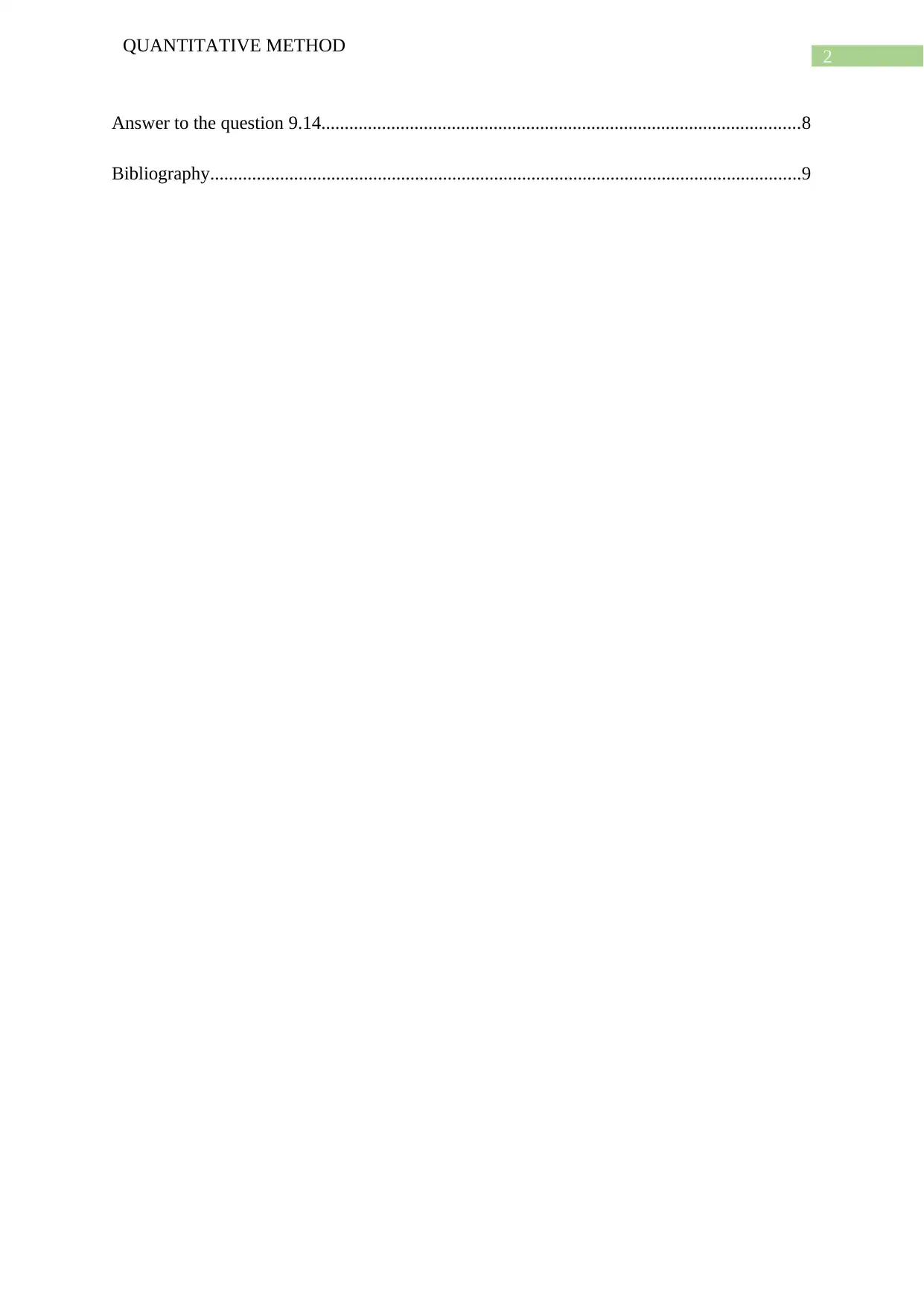
2
QUANTITATIVE METHOD
Answer to the question 9.14.......................................................................................................8
Bibliography...............................................................................................................................9
QUANTITATIVE METHOD
Answer to the question 9.14.......................................................................................................8
Bibliography...............................................................................................................................9
⊘ This is a preview!⊘
Do you want full access?
Subscribe today to unlock all pages.

Trusted by 1+ million students worldwide
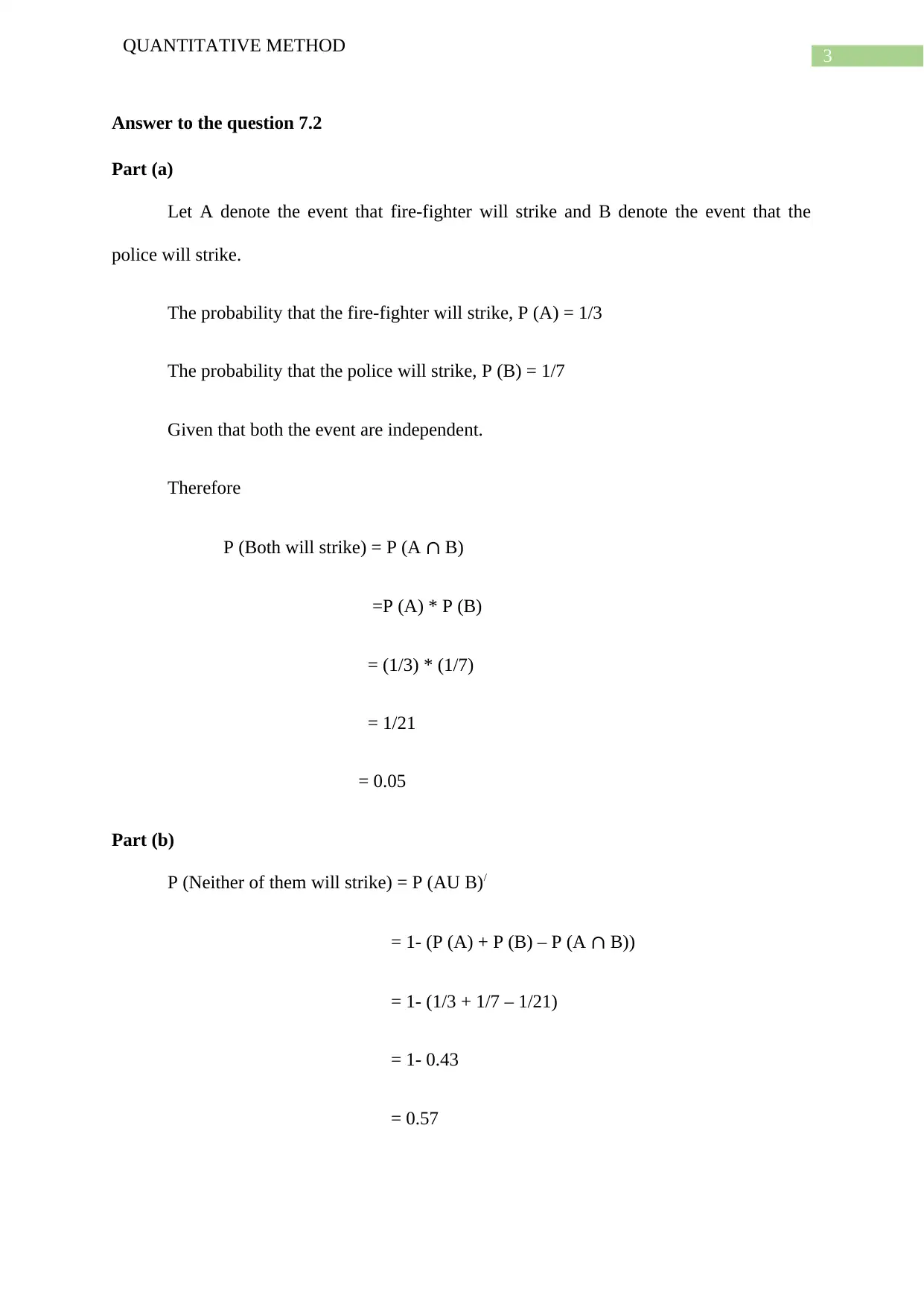
3
QUANTITATIVE METHOD
Answer to the question 7.2
Part (a)
Let A denote the event that fire-fighter will strike and B denote the event that the
police will strike.
The probability that the fire-fighter will strike, P (A) = 1/3
The probability that the police will strike, P (B) = 1/7
Given that both the event are independent.
Therefore
P (Both will strike) = P (A ∩ B)
=P (A) * P (B)
= (1/3) * (1/7)
= 1/21
= 0.05
Part (b)
P (Neither of them will strike) = P (AU B)/
= 1- (P (A) + P (B) – P (A ∩ B))
= 1- (1/3 + 1/7 – 1/21)
= 1- 0.43
= 0.57
QUANTITATIVE METHOD
Answer to the question 7.2
Part (a)
Let A denote the event that fire-fighter will strike and B denote the event that the
police will strike.
The probability that the fire-fighter will strike, P (A) = 1/3
The probability that the police will strike, P (B) = 1/7
Given that both the event are independent.
Therefore
P (Both will strike) = P (A ∩ B)
=P (A) * P (B)
= (1/3) * (1/7)
= 1/21
= 0.05
Part (b)
P (Neither of them will strike) = P (AU B)/
= 1- (P (A) + P (B) – P (A ∩ B))
= 1- (1/3 + 1/7 – 1/21)
= 1- 0.43
= 0.57
Paraphrase This Document
Need a fresh take? Get an instant paraphrase of this document with our AI Paraphraser
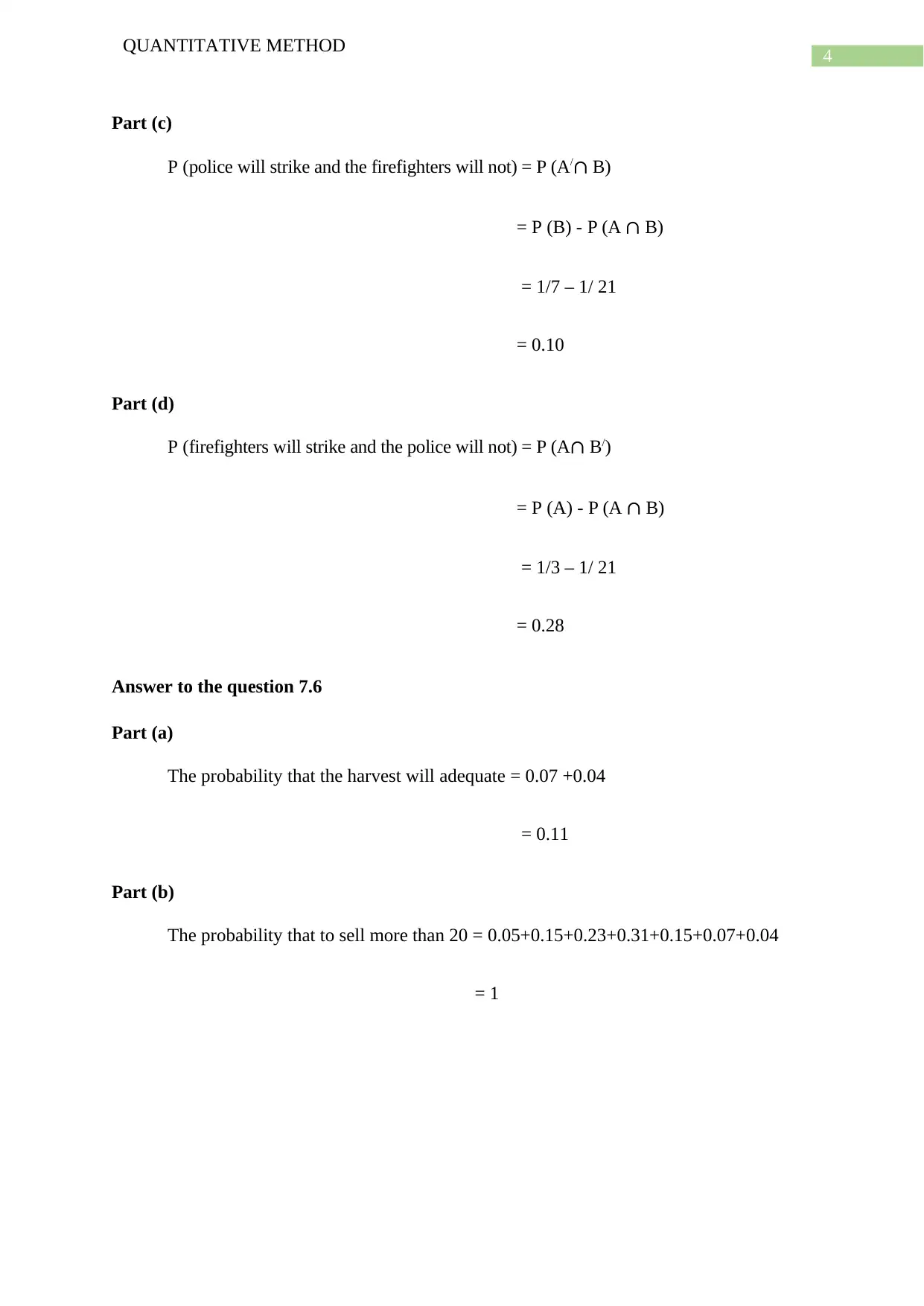
4
QUANTITATIVE METHOD
Part (c)
P (police will strike and the firefighters will not) = P (A/∩ B)
= P (B) - P (A ∩ B)
= 1/7 – 1/ 21
= 0.10
Part (d)
P (firefighters will strike and the police will not) = P (A∩ B/)
= P (A) - P (A ∩ B)
= 1/3 – 1/ 21
= 0.28
Answer to the question 7.6
Part (a)
The probability that the harvest will adequate = 0.07 +0.04
= 0.11
Part (b)
The probability that to sell more than 20 = 0.05+0.15+0.23+0.31+0.15+0.07+0.04
= 1
QUANTITATIVE METHOD
Part (c)
P (police will strike and the firefighters will not) = P (A/∩ B)
= P (B) - P (A ∩ B)
= 1/7 – 1/ 21
= 0.10
Part (d)
P (firefighters will strike and the police will not) = P (A∩ B/)
= P (A) - P (A ∩ B)
= 1/3 – 1/ 21
= 0.28
Answer to the question 7.6
Part (a)
The probability that the harvest will adequate = 0.07 +0.04
= 0.11
Part (b)
The probability that to sell more than 20 = 0.05+0.15+0.23+0.31+0.15+0.07+0.04
= 1

5
QUANTITATIVE METHOD
Answer to the question 7.8
Part (a)
P (the crime is reported) =568/984
Part (b)
P (crime is reported, given that an assault occurs) = 85/568
Part (c)
P (non-reported crime is either a robbery or an assault) = 105/416 + 177/416
= 0.68
Answer to the question 8.2
Mean performance = 27.2
The standard deviation of performance = 4.9
Now
P (22.3 < X < 32.1) = P ( 22.3−27.2
4.9 < Z < 32.1−27.2
4.9 )
= P (-1 < Z < 1)
= 0.6826
P (17.4 < X < 37) = P ( 17.4−27.2
4.9 < Z < 37−27.2
4.9 )
= P (-2 < Z < 2)
= 0.9545
P (12.5 < X < 41.9) = P ( 12.5−27.2
4.9 < Z < 41.9−27.2
4.9 )
QUANTITATIVE METHOD
Answer to the question 7.8
Part (a)
P (the crime is reported) =568/984
Part (b)
P (crime is reported, given that an assault occurs) = 85/568
Part (c)
P (non-reported crime is either a robbery or an assault) = 105/416 + 177/416
= 0.68
Answer to the question 8.2
Mean performance = 27.2
The standard deviation of performance = 4.9
Now
P (22.3 < X < 32.1) = P ( 22.3−27.2
4.9 < Z < 32.1−27.2
4.9 )
= P (-1 < Z < 1)
= 0.6826
P (17.4 < X < 37) = P ( 17.4−27.2
4.9 < Z < 37−27.2
4.9 )
= P (-2 < Z < 2)
= 0.9545
P (12.5 < X < 41.9) = P ( 12.5−27.2
4.9 < Z < 41.9−27.2
4.9 )
⊘ This is a preview!⊘
Do you want full access?
Subscribe today to unlock all pages.

Trusted by 1+ million students worldwide
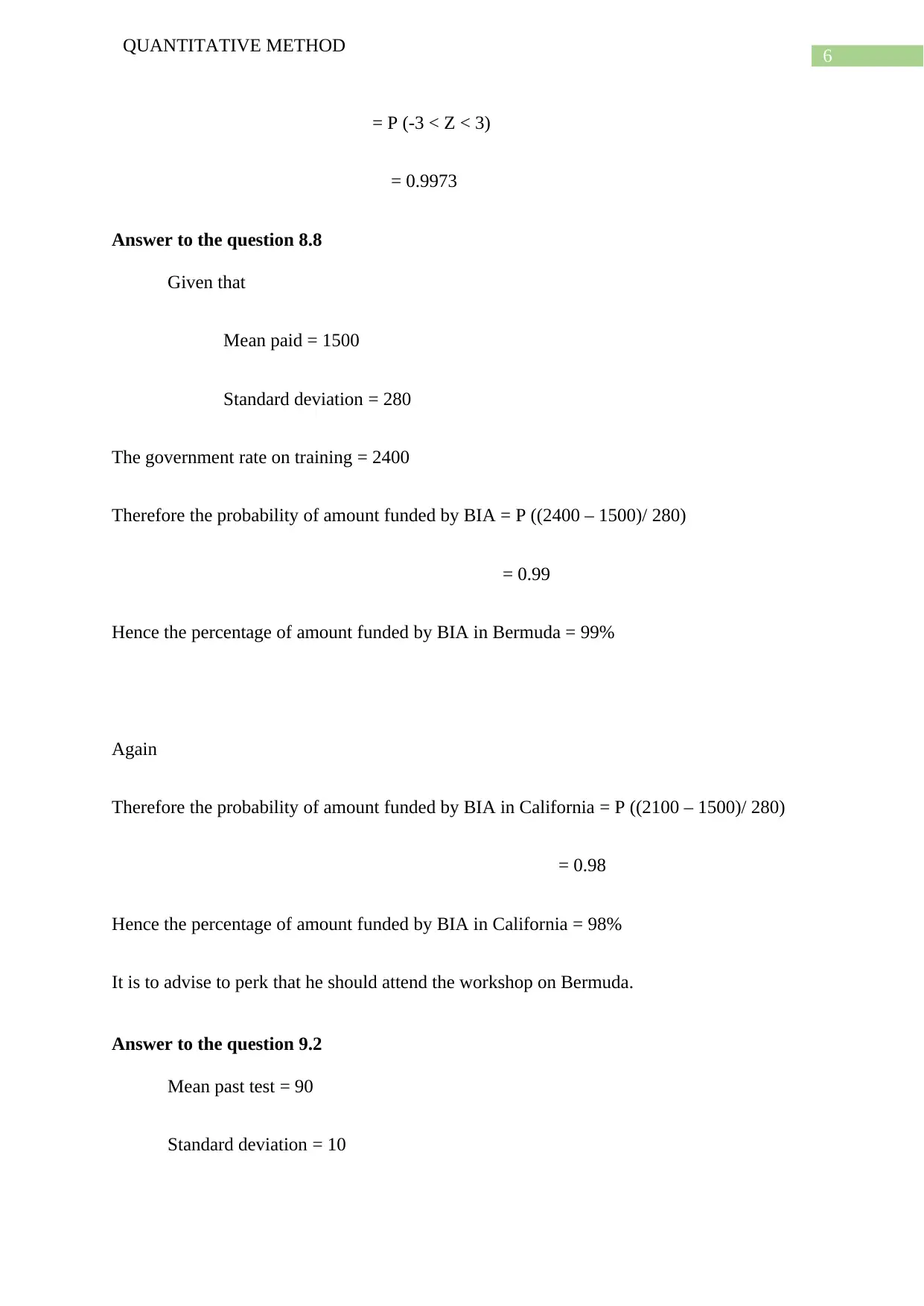
6
QUANTITATIVE METHOD
= P (-3 < Z < 3)
= 0.9973
Answer to the question 8.8
Given that
Mean paid = 1500
Standard deviation = 280
The government rate on training = 2400
Therefore the probability of amount funded by BIA = P ((2400 – 1500)/ 280)
= 0.99
Hence the percentage of amount funded by BIA in Bermuda = 99%
Again
Therefore the probability of amount funded by BIA in California = P ((2100 – 1500)/ 280)
= 0.98
Hence the percentage of amount funded by BIA in California = 98%
It is to advise to perk that he should attend the workshop on Bermuda.
Answer to the question 9.2
Mean past test = 90
Standard deviation = 10
QUANTITATIVE METHOD
= P (-3 < Z < 3)
= 0.9973
Answer to the question 8.8
Given that
Mean paid = 1500
Standard deviation = 280
The government rate on training = 2400
Therefore the probability of amount funded by BIA = P ((2400 – 1500)/ 280)
= 0.99
Hence the percentage of amount funded by BIA in Bermuda = 99%
Again
Therefore the probability of amount funded by BIA in California = P ((2100 – 1500)/ 280)
= 0.98
Hence the percentage of amount funded by BIA in California = 98%
It is to advise to perk that he should attend the workshop on Bermuda.
Answer to the question 9.2
Mean past test = 90
Standard deviation = 10
Paraphrase This Document
Need a fresh take? Get an instant paraphrase of this document with our AI Paraphraser
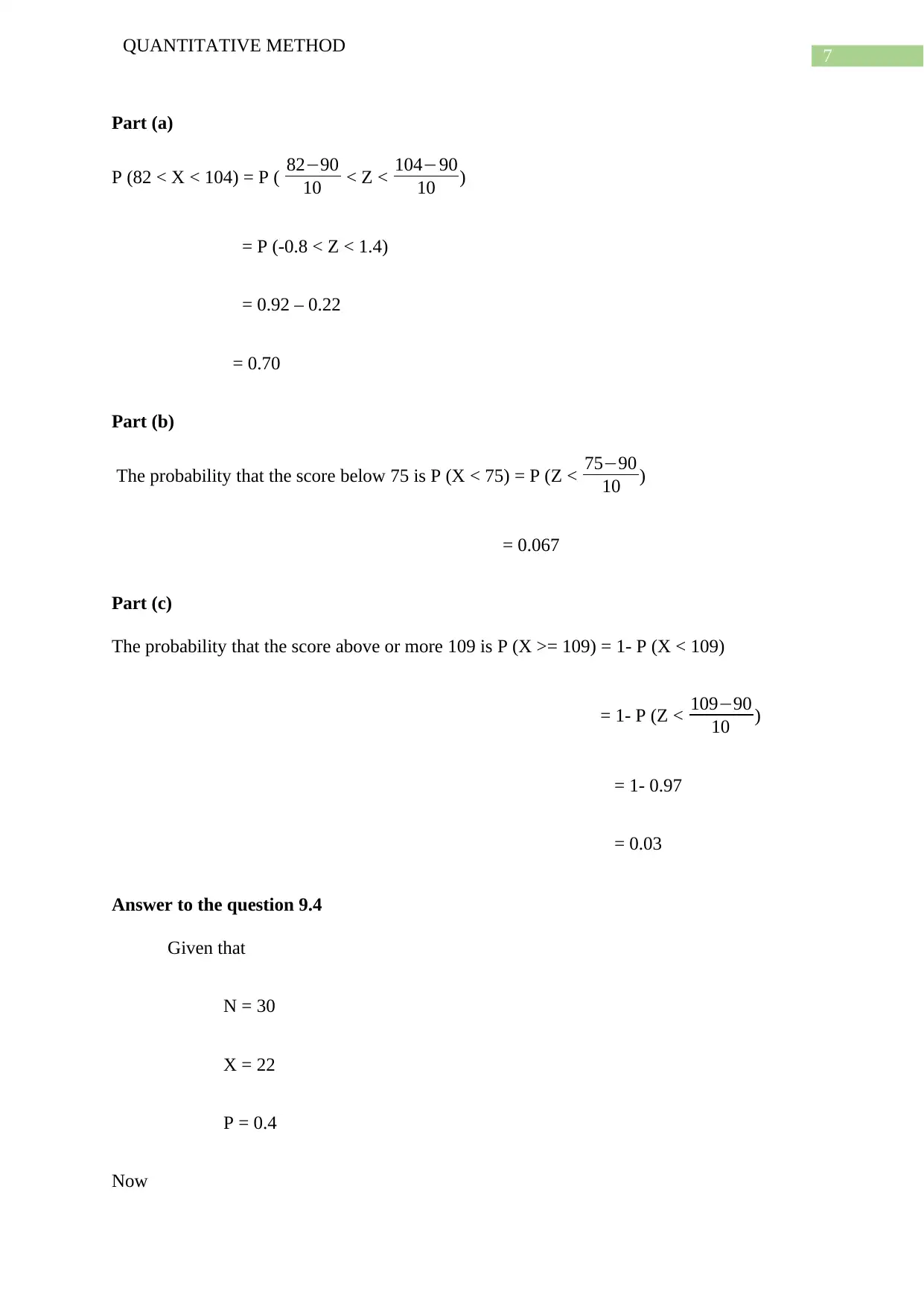
7
QUANTITATIVE METHOD
Part (a)
P (82 < X < 104) = P ( 82−90
10 < Z < 104−90
10 )
= P (-0.8 < Z < 1.4)
= 0.92 – 0.22
= 0.70
Part (b)
The probability that the score below 75 is P (X < 75) = P (Z < 75−90
10 )
= 0.067
Part (c)
The probability that the score above or more 109 is P (X >= 109) = 1- P (X < 109)
= 1- P (Z < 109−90
10 )
= 1- 0.97
= 0.03
Answer to the question 9.4
Given that
N = 30
X = 22
P = 0.4
Now
QUANTITATIVE METHOD
Part (a)
P (82 < X < 104) = P ( 82−90
10 < Z < 104−90
10 )
= P (-0.8 < Z < 1.4)
= 0.92 – 0.22
= 0.70
Part (b)
The probability that the score below 75 is P (X < 75) = P (Z < 75−90
10 )
= 0.067
Part (c)
The probability that the score above or more 109 is P (X >= 109) = 1- P (X < 109)
= 1- P (Z < 109−90
10 )
= 1- 0.97
= 0.03
Answer to the question 9.4
Given that
N = 30
X = 22
P = 0.4
Now
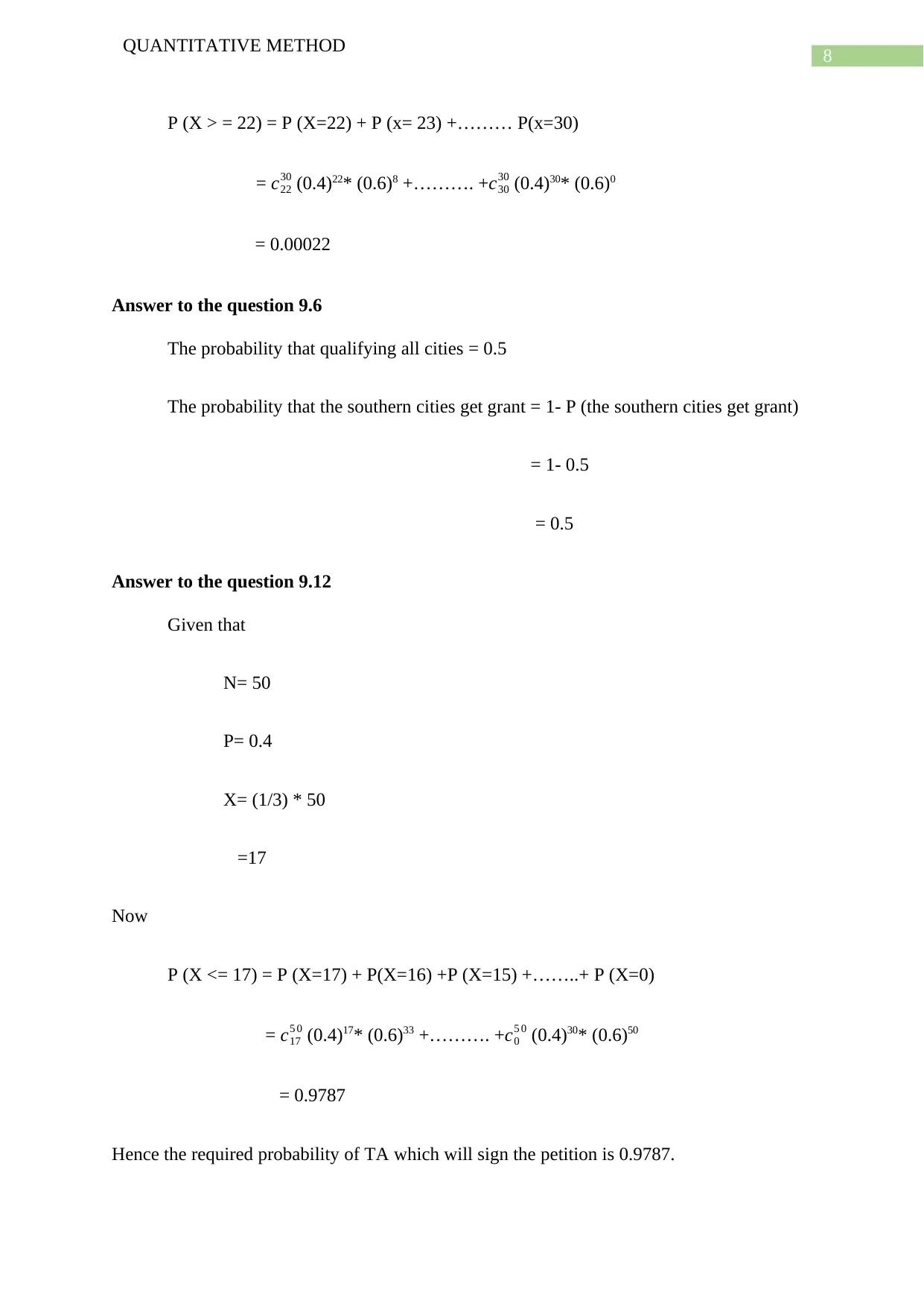
8
QUANTITATIVE METHOD
P (X > = 22) = P (X=22) + P (x= 23) +……… P(x=30)
= c22
30 (0.4)22* (0.6)8 +………. +c30
30 (0.4)30* (0.6)0
= 0.00022
Answer to the question 9.6
The probability that qualifying all cities = 0.5
The probability that the southern cities get grant = 1- P (the southern cities get grant)
= 1- 0.5
= 0.5
Answer to the question 9.12
Given that
N= 50
P= 0.4
X= (1/3) * 50
=17
Now
P (X <= 17) = P (X=17) + P(X=16) +P (X=15) +……..+ P (X=0)
= c17
5 0 (0.4)17* (0.6)33 +………. +c0
5 0 (0.4)30* (0.6)50
= 0.9787
Hence the required probability of TA which will sign the petition is 0.9787.
QUANTITATIVE METHOD
P (X > = 22) = P (X=22) + P (x= 23) +……… P(x=30)
= c22
30 (0.4)22* (0.6)8 +………. +c30
30 (0.4)30* (0.6)0
= 0.00022
Answer to the question 9.6
The probability that qualifying all cities = 0.5
The probability that the southern cities get grant = 1- P (the southern cities get grant)
= 1- 0.5
= 0.5
Answer to the question 9.12
Given that
N= 50
P= 0.4
X= (1/3) * 50
=17
Now
P (X <= 17) = P (X=17) + P(X=16) +P (X=15) +……..+ P (X=0)
= c17
5 0 (0.4)17* (0.6)33 +………. +c0
5 0 (0.4)30* (0.6)50
= 0.9787
Hence the required probability of TA which will sign the petition is 0.9787.
⊘ This is a preview!⊘
Do you want full access?
Subscribe today to unlock all pages.

Trusted by 1+ million students worldwide
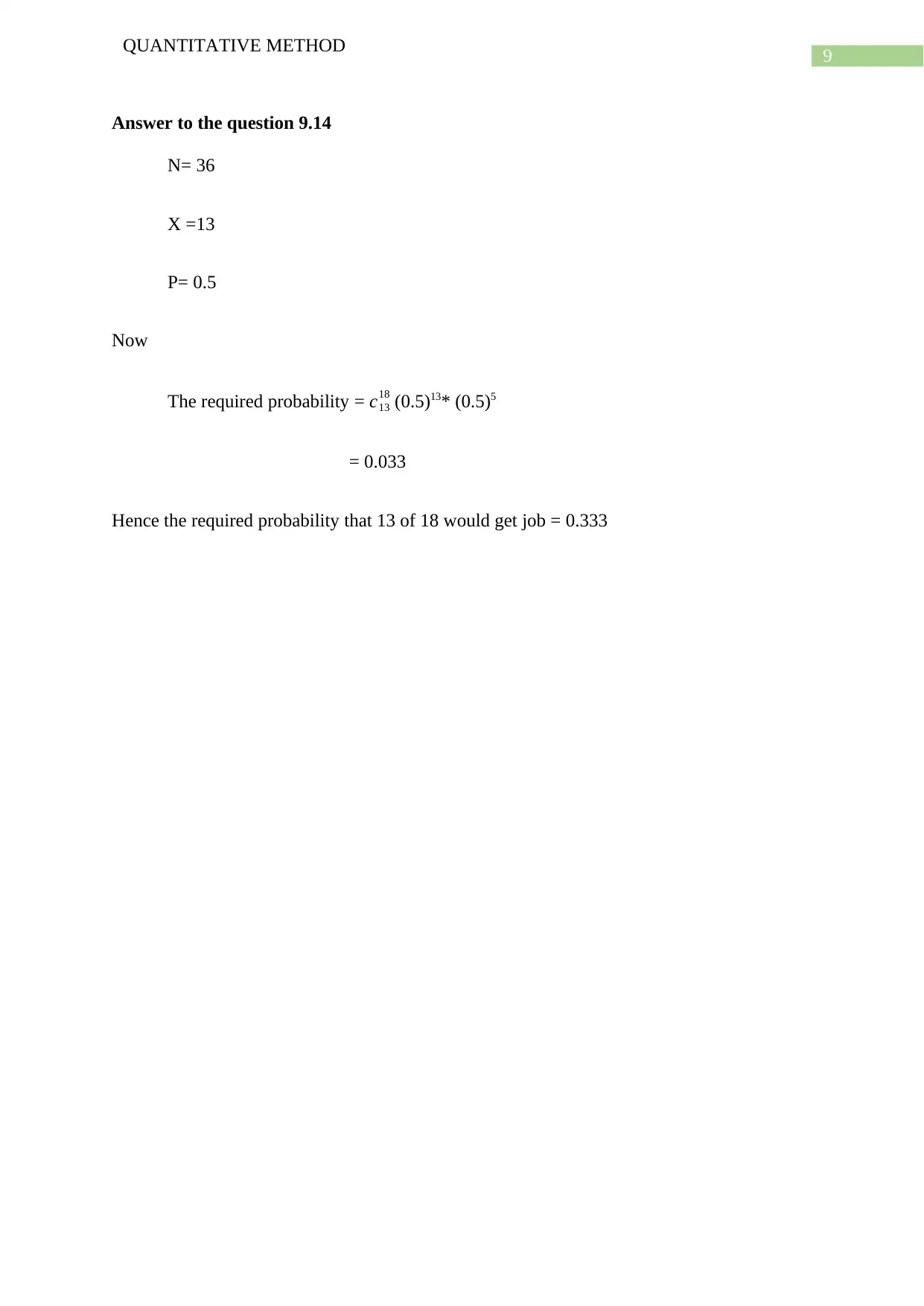
9
QUANTITATIVE METHOD
Answer to the question 9.14
N= 36
X =13
P= 0.5
Now
The required probability = c13
18 (0.5)13* (0.5)5
= 0.033
Hence the required probability that 13 of 18 would get job = 0.333
QUANTITATIVE METHOD
Answer to the question 9.14
N= 36
X =13
P= 0.5
Now
The required probability = c13
18 (0.5)13* (0.5)5
= 0.033
Hence the required probability that 13 of 18 would get job = 0.333
Paraphrase This Document
Need a fresh take? Get an instant paraphrase of this document with our AI Paraphraser
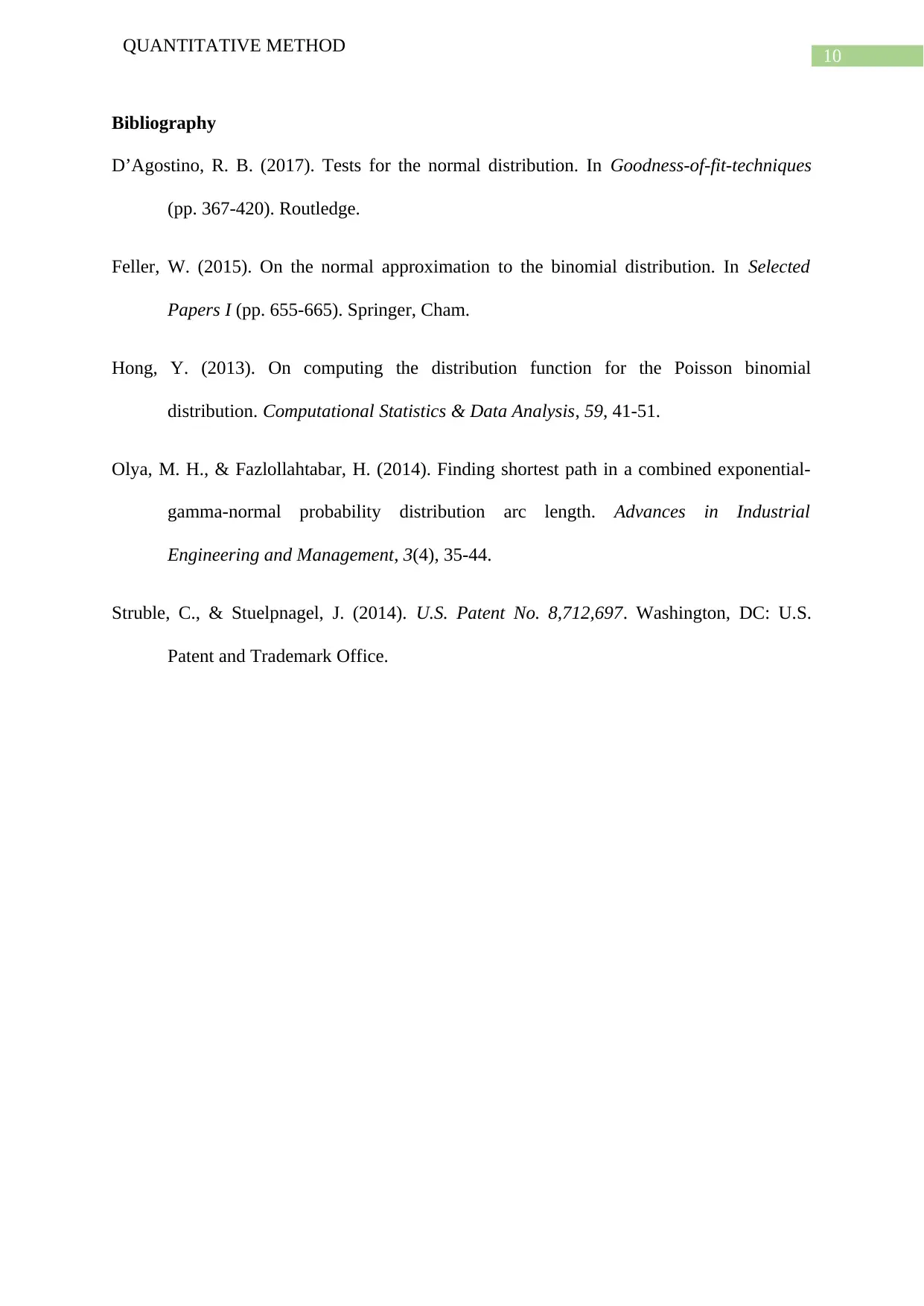
10
QUANTITATIVE METHOD
Bibliography
D’Agostino, R. B. (2017). Tests for the normal distribution. In Goodness-of-fit-techniques
(pp. 367-420). Routledge.
Feller, W. (2015). On the normal approximation to the binomial distribution. In Selected
Papers I (pp. 655-665). Springer, Cham.
Hong, Y. (2013). On computing the distribution function for the Poisson binomial
distribution. Computational Statistics & Data Analysis, 59, 41-51.
Olya, M. H., & Fazlollahtabar, H. (2014). Finding shortest path in a combined exponential-
gamma-normal probability distribution arc length. Advances in Industrial
Engineering and Management, 3(4), 35-44.
Struble, C., & Stuelpnagel, J. (2014). U.S. Patent No. 8,712,697. Washington, DC: U.S.
Patent and Trademark Office.
QUANTITATIVE METHOD
Bibliography
D’Agostino, R. B. (2017). Tests for the normal distribution. In Goodness-of-fit-techniques
(pp. 367-420). Routledge.
Feller, W. (2015). On the normal approximation to the binomial distribution. In Selected
Papers I (pp. 655-665). Springer, Cham.
Hong, Y. (2013). On computing the distribution function for the Poisson binomial
distribution. Computational Statistics & Data Analysis, 59, 41-51.
Olya, M. H., & Fazlollahtabar, H. (2014). Finding shortest path in a combined exponential-
gamma-normal probability distribution arc length. Advances in Industrial
Engineering and Management, 3(4), 35-44.
Struble, C., & Stuelpnagel, J. (2014). U.S. Patent No. 8,712,697. Washington, DC: U.S.
Patent and Trademark Office.
1 out of 11
Your All-in-One AI-Powered Toolkit for Academic Success.
+13062052269
info@desklib.com
Available 24*7 on WhatsApp / Email
![[object Object]](/_next/static/media/star-bottom.7253800d.svg)
Unlock your academic potential
Copyright © 2020–2025 A2Z Services. All Rights Reserved. Developed and managed by ZUCOL.
